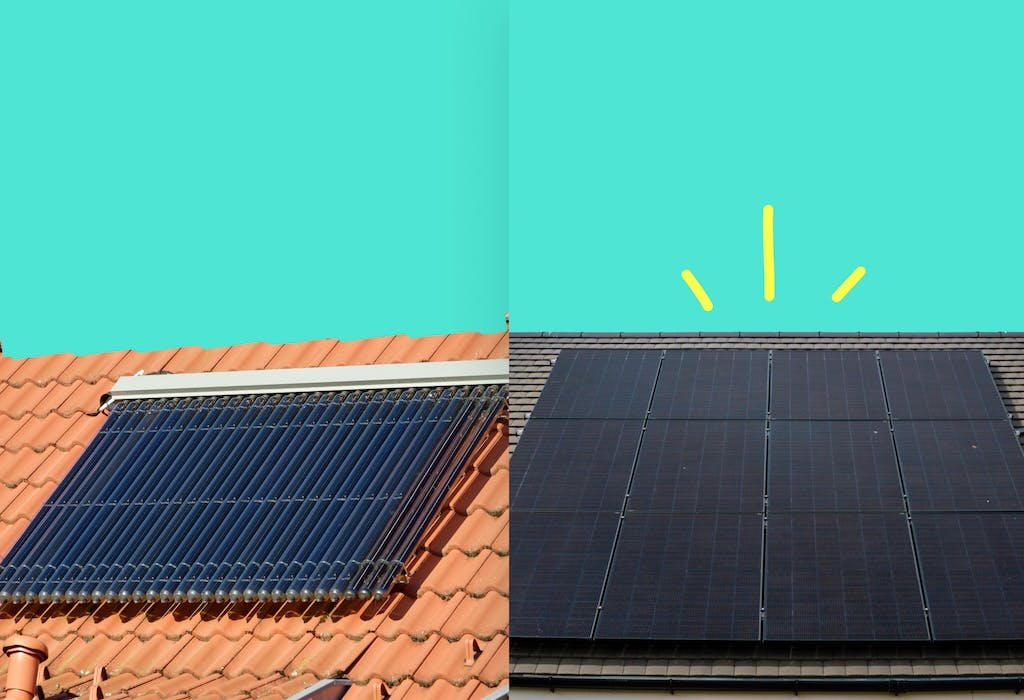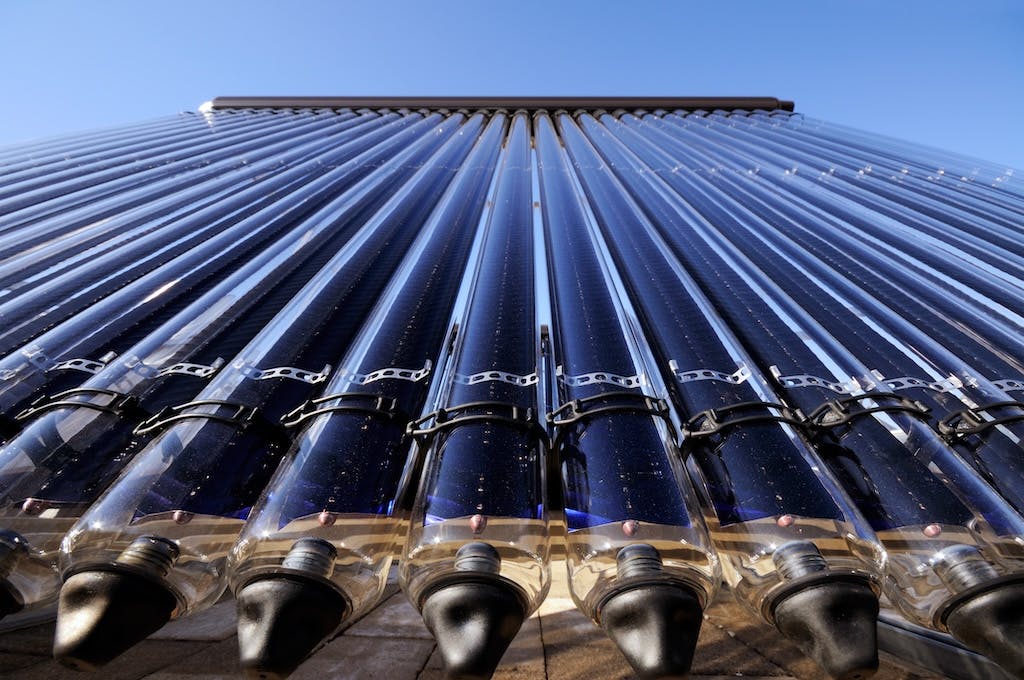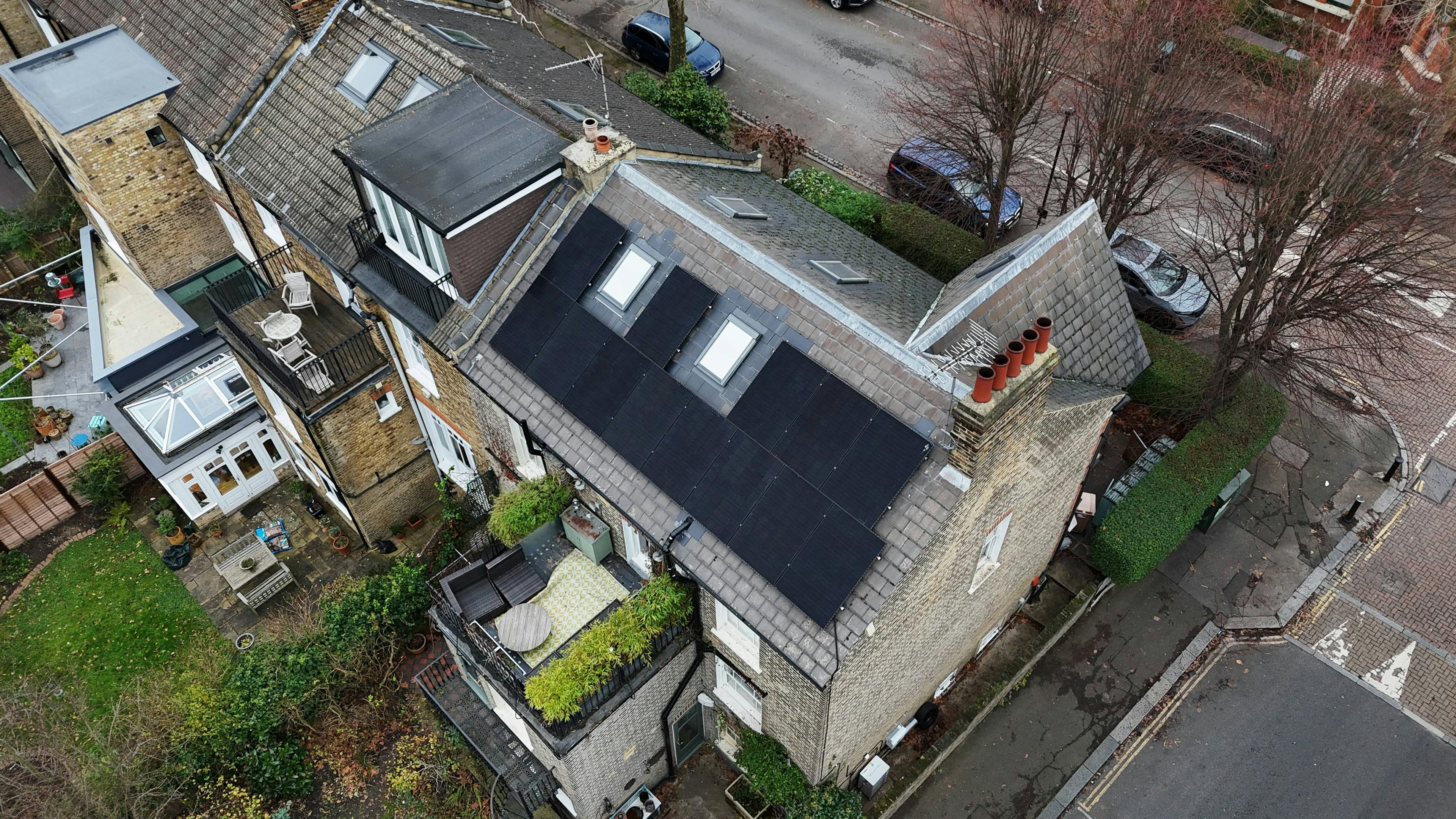- Solar advice hub
- Solar-technology
- Solar thermal vs solar PV: which is better?
Solar thermal vs solar PV: which is better?
Choosing between solar thermal panels and solar photovoltaic panels? Find out which is better when it comes to key factors like costs, savings, and government funding.


Why you can trust our content
We know that the solar industry is full of misinformation, but we only use reliable sources, including:
- Our experienced solar experts, installers and system designers
- Our own database of solar & battery system designs
- Authoritative bodies like MCS and the UK government




Solar thermal vs solar PV: at a glance
Both solar thermal and solar photovoltaic (PV) systems use the sun’s rays to lower your household’s energy bills – but with a few key differences.
Most importantly: solar thermal systems use the sun’s warmth to heat your water supply, whilst solar PV systems convert the sun’s light into electricity.
In this guide, we’ll explain how solar thermal panels work, how popular they are, and compare them in detail with solar PV panels.
If you’re wondering how much you could save with a solar PV system and storage battery, enter a few details below and we’ll generate a quick estimate.
Find out how much you can save
What kind of home do you live in?
What are solar thermal panels?
Solar thermal panels sit on your roof and use the sun’s energy to heat your home’s hot water supply.
They can provide a significant amount of the warmth required to transform some of your cold mains supply into hot water - you know, the stuff you need for things like showers, baths, and washing clothes.
This helps you save a substantial amount of money on the energy needed to heat your water – and like solar PV systems, they utilise the renewable power of the sun.
They can be added to traditional boiler setups relatively easily, especially if you already have a hot water cylinder.
If you get an especially large array, solar thermal panels can also slightly reduce your home’s central heating bills, but it’s not usually worth the upfront cost.
How do they work?
Solar thermal panels convert the sun’s infrared rays to heat, and store this warmth in a mixture of water and glycol.
The system’s heat exchanger will send this fluid through the pipes to heat up the mains water in your hot water cylinder, usually via a coil made of stainless steel or copper.
You can still get solar thermal panels if you have a combi boiler, but you’ll need to get a hot water tank installed.
Solar thermal systems come in two forms, both of which will usually go on your roof.
You can either get flat plate collectors – which are dark rectangles that look like solar panels – or evacuated tube systems, which are mainly composed of insulated glass tubes. Both function in more or less the same way, with slightly varied results.
All of this is a world away from how solar panel systems work, which is by using the sun’s photons to create an electric current, then converting it from direct current (DC) to alternating current (AC) electricity that can be used at home and exported to the grid.
But both systems can be extremely productive on your roof, and both make excellent use of the near-endless energy that the sun supplies.

How many homes in the UK have solar panels?
There have been 43,385 installations of solar thermal panel systems in the UK, as of December 2024, according to the Microgeneration Certification Scheme (MCS).
They experienced a spike in popularity during mid-2021, when the monthly installation figures regularly hit 1,000, but have since largely fallen out of fashion.
Fewer than 900 installations were carried out in 2022 and 2023 combined, and 2024 saw the number drop under 200 - its lowest point since records began in 2009.
This is the polar opposite of solar panels, which are surging in popularity, with installations growing by 26% since the start of 2023, according to government data.
As energy bills have spiralled in recent years, households have realised that solar panels can cut their costs, particularly as suppliers provide increasingly generous solar export tariffs.
More than 1.5 million UK homes have now installed solar panels, which is over 5% of all households in the country.
Number of UK homes with solar thermal vs solar PV
Solar thermal panels vs solar PV panels
Let’s see how these two renewable technologies compare with each other, based on the following seven factors:
- Cost
- Savings
- Suitability in the UK
- Government grants
- Lifespan
- Durability & maintenance
- Compatibility with other tech
1. Cost
To purchase solar thermal panels, you’ll generally pay about £6,000, according to the Energy Saving Trust.
A solar panel system is usually pricier – a 3 kilowatt-peak (kWp) solar panel system for a property with two or three bedrooms costs around £9,000, including installation.
In both cases though, how much you pay will depend on what type of panels you choose, how large your system is, and which installer you hire.
If the high upfront cost of a solar installation puts you off, you should consider Sunsave Plus, the UK’s first solar subscription.
You can get a solar & battery system with no upfront cost, and instead spread the cost across 20 years of fixed monthly payments.
Each Sunsave Plus system is also protected by the Sunsave Guarantee for the full term, which includes 24/7 monitoring and maintenance, free replacement parts, downtime cover, and insurance.
To sign up for Sunsave Plus, enter a few quick details below and we’ll get in touch.
Find out how much you can save
What kind of home do you live in?
2. Savings
Solar thermal systems can save you around 50% on the cost of your hot water, according to the Energy Saving Trust.
For the average household with a gas boiler, this adds up to £110 per year on average, rising to £200 per year for homes with an electric boiler.
On the other hand, you could save 86% on your electricity bills with a solar & battery system, on average.
Your panels will significantly shrink the amount of electricity you need to buy from the grid, and you’ll also earn money by selling your excess electricity to the grid.
This figure is based on a sample of over 150 systems installed by Sunsave across England and Wales in 2024. The average system is 6.1kWp, with 54% of solar electricity used at home and 46% exported to the grid.
3. Suitability in the UK
Both solar thermal and PV systems are more than suitable in UK weather, as shown by the fact that they can significantly cut your heating and electricity bills, respectively.
Both systems, if sized correctly, can deliver at least as much energy as you require in the summer, when the days are longer, the skies are clearer, and the sun shines most consistently.
Both also drop off noticeably in winter, but while solar thermal setups will generally only supply 25% of your hot water needs when the weather turns colder, a solar & battery system can still provide around half of your electricity.
In terms of roof suitability, solar thermal and solar PV have practically identical needs: a lack of shading, an angle of around 40 degrees, and a roof that faces south, east, or west.
Fortunately, most homes in the UK have pitched roofs that sit around 40 degrees, and have the strength to hold a solar thermal or PV system without any difficulty.

4. Government grants
You may be eligible for heavily discounted or free solar panels through four main government grants: the ECO4 scheme, the Home Upgrade Grant (HUG), the Warm Homes: Social Housing Fund, and the Welsh government’s Warm Homes Programme.
ECO4 is mostly only open to households that primarily use an electric heating system and receive a qualifying benefit, though low-income and vulnerable households – plus social homes with poor Energy Performance Certificate (EPC) ratings – can also qualify.
The Home Upgrade Grant requires applicants not to use a gas boiler as their main heating system, while the Warm Homes: Social Housing Fund is limited to social housing providers whose properties have low EPC scores – and both are restricted to households in England.
You may be able to access the Warm Homes Programme if your home has a low EPC rating and you receive a qualifying benefit, but it’s only open to people in Wales.
If you’re eligible, you may also be able to get solar thermal panels through the HUG – but it’s not very common.
Since the start of the HUG in 2023, the government has provided funding for 30 solar thermal systems, according to government data from December 2024.
In contrast, the initiative has funded 4,444 solar PV systems to date – by far the most popular measure taken under the scheme.
Social housing providers can also apply for solar thermal panels through the Warm Homes: Social Housing Fund, since the scheme supports the use of low-carbon heating systems.
5. Lifespan
Solar thermal systems usually last around 20 years, but may last for up to 30 years if they’re properly maintained, according to the latest scientific research.
However, their warranties are usually for 10 years at most.
Once again, solar panels are superior, with a lifespan that generally ranges from 30 to 40 years if you opt for monocrystalline panels.
Considering the majority of installers in the UK now use these panels, you should be able to make the most of your investment for decades to come. Top-tier manufacturers will also provide you with product and performance warranties that both last for at least 25 years, showing their confidence in their products.
6. Durability and maintenance
Solar thermal panels should preferably undergo annual inspection checks, according to the MCS, to make sure every part of the system is functioning properly.
In addition, the mixture of water and glycol should be tested every five years, at a minimum.
Solar panels, in contrast, do not require annual inspection - although they do still need maintenance. Technical experts in the industry estimate that a solar & battery system will require three call-outs in 20 years: one for the panels, one for the battery, and one for the inverter.
Solar panels also need cleaning every two or three years in the UK, but this will need to be more frequent if you live near dusty farmland or right by the sea.
Fortunately, every Sunsave Plus system is protected by the Sunsave Guarantee, which includes 24/7 monitoring and maintenance, free replacement parts (including a battery and inverter), downtime cover, and insurance. Click here to find out more.
7. Compatibility with other tech
Solar thermal panels aren’t especially designed for compatibility with other appliances, except your hot water cylinder.
They therefore don’t really open up any possibilities for households, beyond cutting down on the amount of energy you need from other sources to heat your water supply.
On the other end of the scale, solar PV systems generate their own electricity, and so are compatible with anything that runs on electricity.
What’s more, they’re compatible with most of the other barrier-breaking technologies that can cut your emissions and energy bills.
The UK’s electricity consumption is set to rise by 50% between 2020 and 2035, according to the independent Climate Change Committee, mainly due to an enduring spike in the popularity of heat pumps and electric vehicles.
And solar panels are perfectly positioned to make this rapid transition possible and affordable for households all over the country.
Solar thermal or solar PV: our verdict
For the vast majority of homes in the UK, solar panel systems are the better choice.
A solar thermal setup is a useful addition for a household looking to cut its carbon footprint, but can’t provide the kind of savings to make the initial investment worth it.
Solar PV systems are clearly superior in terms of savings, lifespan, and maintenance requirements.
They’re also compatible with heat pumps and electric vehicles, which are set to shape the future of domestic heating and transport in the UK.
If you’re wondering how much you could save with a solar panel system and storage battery, enter a few details below and we’ll generate a quick estimate.
Find out how much you can save
What kind of home do you live in?
Solar thermal vs solar PV: FAQs

Written byJosh Jackman
Josh has written about the rapid rise of home solar for the past six years. His data-driven work has been featured in United Nations and World Health Organisation documents, as well as publications including The Eco Experts, Financial Times, The Independent, The Telegraph, The Times, and The Sun. Josh has also been interviewed as a renewables expert on BBC One’s Rip-Off Britain, ITV1’s Tonight show, and BBC Radio 4 and 5.